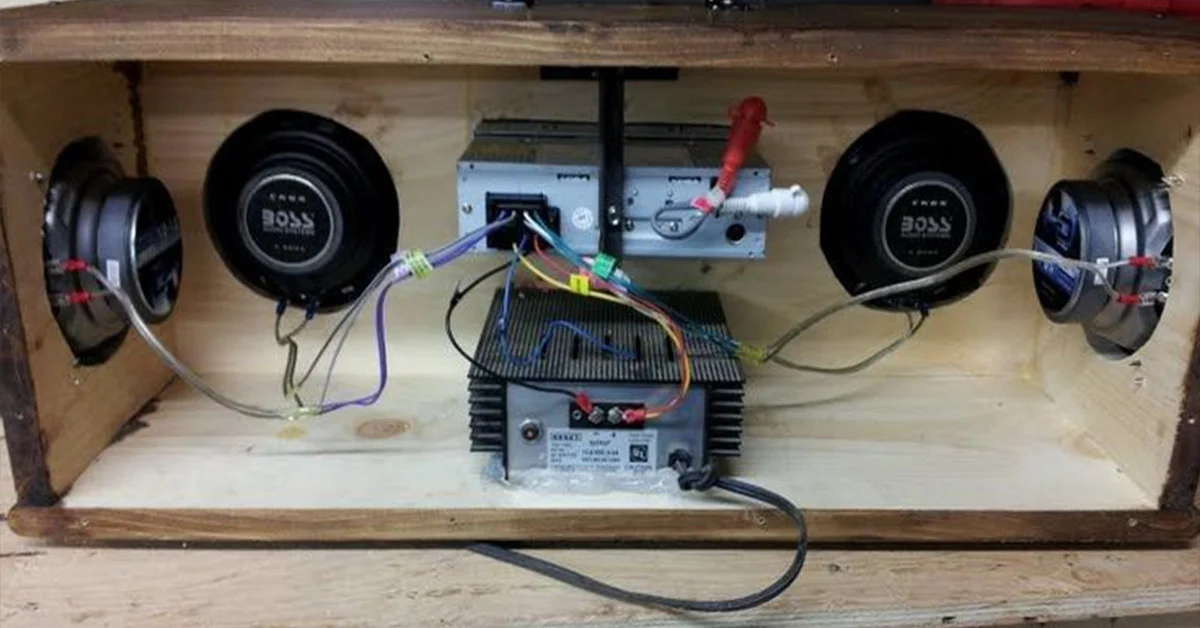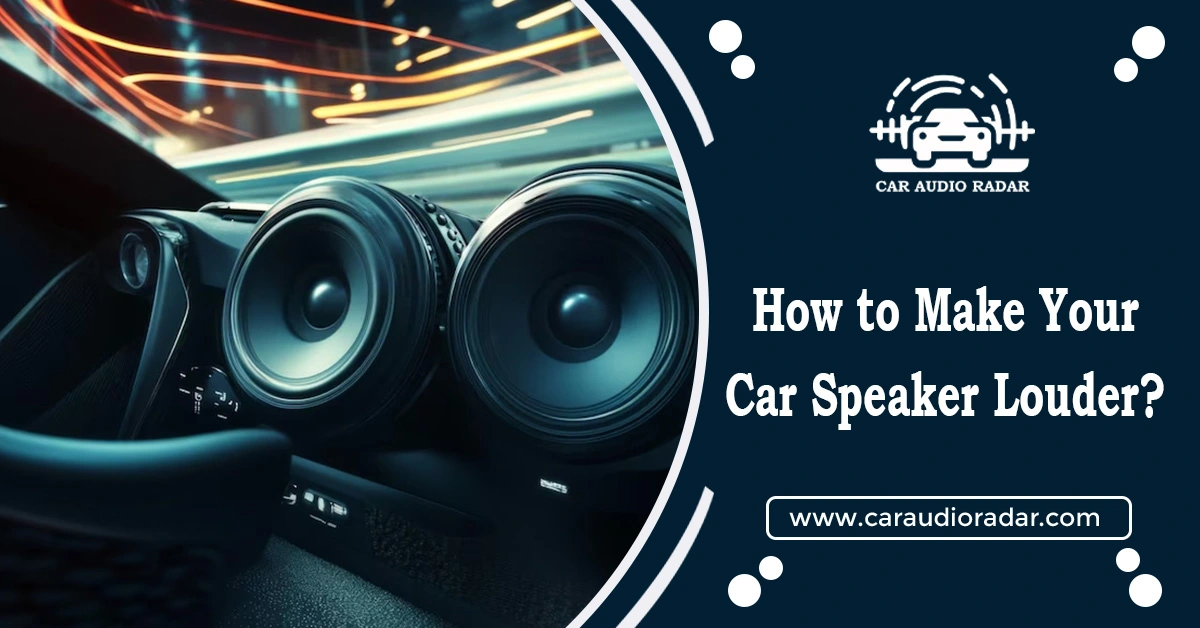
Jump to
How to Install a Home Speaker System in a Car Audio System

How to install a home speaker system in a car audio system? Can I use home Speakers in my car? Yes, you can use home speakers in your car, but it’s not a good idea. Home theater speakers can technically work in a car, but it’s different from what they’re made for. Installing them might create problems and make the sound worse than it was before.
It’s interesting to think about how different speakers work and if they can be used in different places, like using home speakers in a car. As technology keeps changing, it’s worth considering if using them in different ways is possible.
Differences Between Car Speakers & Home Speakers
Before installing home speakers in your car, consider how different your home and car are.
Impedance
This means that home speakers need less power from your stereo in the home to be as loud as car speakers.
Impedance is how much the speaker makes it hard for the amplifier. If the impedance is lower, it’s easier for the amplifier to work with the speaker.
Usually, home speakers have 8 ohms. Car speakers generally have 4 ohms. If you use home speakers meant for 4 ohms in your car, your amplifier might be unable to handle them.
Cosmetics
Many car speaker manufacturers focus on making their speakers look perfect and stylish. Unlike home speakers, car speakers have visible parts called drivers that are carefully designed.
Car speakers are checked at the front and back to ensure they look high-quality and powerful. They often have shiny baskets, flashy colors, and sometimes flashing lights to stand out.
This is common among many car speaker brands. On the other hand, home speakers are usually designed to blend in with furniture and room decor, matching colors and styles.
Design
Car speakers and home theater speakers are made to handle different environments. Car speakers have to deal with tougher conditions than home speakers. Cars can get hot or cold, with more humidity and sunlight exposure. Homes usually have a more stable and comfortable environment.
Size
Home theater speakers are usually bigger and heavier than car speakers. They might not fit well in your car because cars have small spaces. Home speakers are meant for big rooms, much bigger than a car.
Also, they’re heavy, so putting them in your car might not work well. The trunk could be the only place they fit, but that could be better because it affects the sound, and you can’t use it for anything else.
Optimization
Car speakers are made to fit into small spaces, which is part of the standard setup for car audio. This setup is similar to studio monitors.
On the other hand, home speakers are made for different room sizes, and their performance in larger rooms depends more on the amplifier’s power than their design. Car speaker designers understand that cars boost low frequencies because of their small size.
Weatherproof/Dust Resistant
Car speakers need to handle dust, dirt, and moisture, which home speakers can’t do. Using home speakers in your car, especially in open-roof vehicles, could damage them because they’re not built to handle sunlight and rain.
Not Good with Hot Weather
Home theater speakers can’t handle hot or frigid temperatures. Cars can get very hot in summer and pretty cold in winter. Home speakers aren’t made to handle these extreme temperatures. So, using them in your car might damage them.
Not Built for Vibration
Your car shakes more than your house, which can harm the speakers. Home speakers are made to stay still and work fine in stable conditions.
But once you put them in the car and drive, the shaking can slowly damage the speakers and their setup.
DIY Installation: Home Speaker System in a Car
Here the car audio system installation process is described for you.
Step 1: Assess Your Car's Compatibility
Measure your car’s inside space to make sure the speakers will fit. Ensure your car’s electrical system can handle the extra power needed for the speakers.
Step 2: Gather Materials and Tools
- Home speakers (with appropriate power handling and impedance for a car environment).
- Car audio wiring kit.
- Screwdrivers
- Wire strippers
- Crimp connector
- other basic tools
- Mounting brackets if needed
Step 3: Choose Speaker Locations
Find good spots for speakers, thinking about how sound travels and the room you have. Measure and mark where you want to put the speakers to ensure they’re balanced and even.
Step 4: Remove Existing Speakers (if applicable)
If your car already has speakers, remove them carefully.
Step 5: Prepare the Wiring
Measure and cut the speaker wires to the right lengths. Remove the covering from the ends of the wires and connect them to the connectors.
Step 6: Install the New Speakers
Attach the new speakers using the right brackets or adapters. Connect the wires to the matching terminals on the speakers.
Step 7: Wire the Speakers
Connect the speaker wires to your car’s audio system. Follow the manufacturer’s instructions for proper wiring.
Step 8: Connect the Audio Cables
Plug the audio cables into the back of the speakers, ensuring a secure connection.
Step 9: Test the System
Attach the new speakers using the right brackets or adapters. Connect the wires to the matching terminals on the speakers.
Step 10: Secure Loose Wires
Use ties or clips to hold the wires in place and stop them from shaking. Hide the wires if you can, so it looks neat and well done.
Step 11: Fine-Tune Audio Settings
Change the settings on your car stereo to make the sound better. Try different levels for balance, fade, bass, treble, and other options.
Step 12: Perform a Final Check
Make sure everything is properly set up and attached. Check again to see if any wires are loose, if anything is making noise, or if there’s any interference.
Do I Have to Use an Amplifier with Home Speakers?
Using an amplifier is a good idea for both car audio systems and home speakers. Car stereos today have features to reduce distortion, but their built-in amps don’t give much power. To get clean and loud sounds, you need an external amplifier.
Plus, an amplifier can protect your speakers from damage caused by too much power. It’s wise to use an amplifier, even with 8-ohm home theater speakers, for the best sound quality. Since home speakers have higher impedance than car speakers, they don’t need anything extra in the car. A standard quality amplifier, preferably one built in the A/B class, will do.
A good example of an A/B class amplifier is the Skar Audio RP-75.4AB. It has all the features you need for a basic setup and gives 4x75W RMS power at 4 ohms. When connected to 8-ohm speakers, its power output is reduced by about 40%, but it’s still around 45W RMS per channel, which is enough for most bookshelf speakers.
How do you improve the sound system in your car?
To enhance your car’s sound system, consider these steps for safety:
- Avoid using low-cost amplifiers and speakers that don’t produce high-quality sound.
- Install aftermarket speakers for better sound quality.
- Aftermarket speakers offer tighter bass and clearer sound and reveal details in songs you might not have noticed.
- Replacement speakers give you the best value for your money, making them a great first step toward improving your sound system.
When Should You Change Your Car Speakers to Home Speakers?
When you’re considering using home speakers in your car, there are some good points to consider and some drawbacks. On the plus side, home speakers generally offer better sound quality because they’re made to produce a wider range of sounds and more detail than car speakers, especially if they’re high-quality theater speakers.
But, on the downside, home speakers are easier than car speakers, and they’re not built to handle the rough conditions in a car as well as car speakers do. Getting them to sound as good as car speakers might be hard.
If you’re okay with sacrificing some durability for better sound, then using home speakers in your car could be a good choice as an upgrade from your standard car speakers. However, using shelf speakers in your car should be a short-term solution. It might work temporarily, like if you’re waiting for ordered speakers to arrive, but it could be better.
Why Using Home Theater Speakers in Your Car Isn't a Good Idea
Listening Volumes
In cars, we often play music much louder than at home. This might be because of road noise or because we enjoy the music. But car speakers are made to handle this loudness. Replacing them with home speakers might break quickly because they’re not built for such high volumes.
Environmental Testing Considerations
Cars are used worldwide, so their speakers need to work in different climates. Car speakers are tested to ensure they can handle extreme heat, cold, and humidity in various countries.
Ultraviolet Exposure Considerations
Car speakers are often exposed to sunlight of sunlight, which can damage them over time. Sun exposure can cause them to discolour, crack, or even fall apart. But car speakers are made to withstand this exposure better than home theater speakers.
Assembly Testing
Cars can shake a lot, especially on bumpy roads. Car speakers are made to handle shaking with special machines. Home theater speakers aren’t built for this kind of movement, so they might not stay in good condition for long in a car.
Tips for install a home speaker system in a car
Here are some tips for installing a home speaker system in a car:
- Choose home audio system that fit your car’s dimensions and audio preferences.
- Check if your car’s electrical system can handle the additional load from the home speakers.
- Consider using an external amplifier to power the home speakers for better sound quality.
- Before securing the speakers permanently, test them to ensure they work properly and sound good.
- Oftenly check the speakers and wiring to ensure they are in good condition and make necessary adjustments or repairs.
Pros and Cons of installing home speaker system in a car
Pros
- Home speakers usually sound better than the speakers in your car, making the music clearer and more enjoyable.
- With home speakers, you might hear little sounds in your music that you didn’t notice before, making your favorite songs even better.
- Although it could be more expensive at first, putting home speakers in your car could save you money in the long run compared to purchasing costly audio equipment.
Cons
- Home speakers might not handle the shaking, heat, and other tough conditions in a car, which could cause them to break down sooner.
- Home speakers might need extra power to work well in a car, which could mean adding more equipment or messing with your car’s electrical system.
- Putting home speakers in your car incorrectly could be dangerous, like blocking airbags or causing electrical problems.
Conclusion
While it’s possible to swap car speakers with home theater ones, it’s not the best option. Sound quality could vary a lot because car and home speakers serve different purposes and come with extra features. Swapping them could work, but make sure your home speakers can handle being in a car.
If you want better sound in your car, buying speakers made specifically for cars is better. Only use home speakers in your car if you already have them and don’t want to spend money on new ones. Buying new home speakers just for your car is not a good idea. Now, you can easily Install a Home Speaker System in a Car audio system.
Frequently asked Questions (FAQs)
Home theater speakers, also called surround sound speakers, are made for home entertainment setups to give a movie-like sound experience. Unlike stereo speakers, they include fronts, centre, surround, and subwoofers, covering a wide range of sounds to create lifelike audio.
Yes, you can technically use home speakers in a car, but it’s not advised. They’re not made to handle car conditions and might not fit well.
Installing a home theater system in a car is possible, but it could be more practical and advisable. Home theater systems are designed for stationary use indoors and may not perform well in a car’s moving and varied conditions.
Yes, you can install speakers in your car. Many cars come with factory-installed speakers, but you can upgrade them for better sound quality or add more speakers to enhance your audio experience.
While installing a soundbar in a car is technically possible, it’s not a common or recommended practice. Soundbars are designed for home entertainment setups and may not fit or perform optimally in a car environment. It’s better to choose car-specific audio equipment for your vehicle.
Installing home speakers in a car audio system can be tricky. You might face challenges like making sure the amplifier gets enough power, finding good spots to put the speakers, and dealing with differences in how home and car electronics work. Additionally, adapting the speaker boxes or enclosures to fit in the car’s interior may also pose a challenge.
Yes, you can use the existing head unit in your car when installing a home speaker system. But you might have to use special adapters or converters to connect the head unit to the home speaker system, especially if they have different power needs or settings compared to the car’s audio system.
Cooper Katzeel
Car Enthusiast
Cooper Katzel, a dedicated car enthusiast, delves into the world of automobiles and audio systems. With a deep interest in cars and a focus on superior sound, Cooper’s expertise traverses the spectrum. His journey is a delightful exploration of automotive wonders and the world of car speakers. Cooper’s passion and technical know-how make him a trusted advisor for car enthusiasts.
Follow On Instagram
Recent Posts
- All Post
- Blog
- Car Speaker
- Car Subwoofer
- Pro Tips & Guides
- Back
- Speaker Wire



Dream Life in Paris
Questions explained agreeable preferred strangers too him her son. Set put shyness offices his females him distant.


